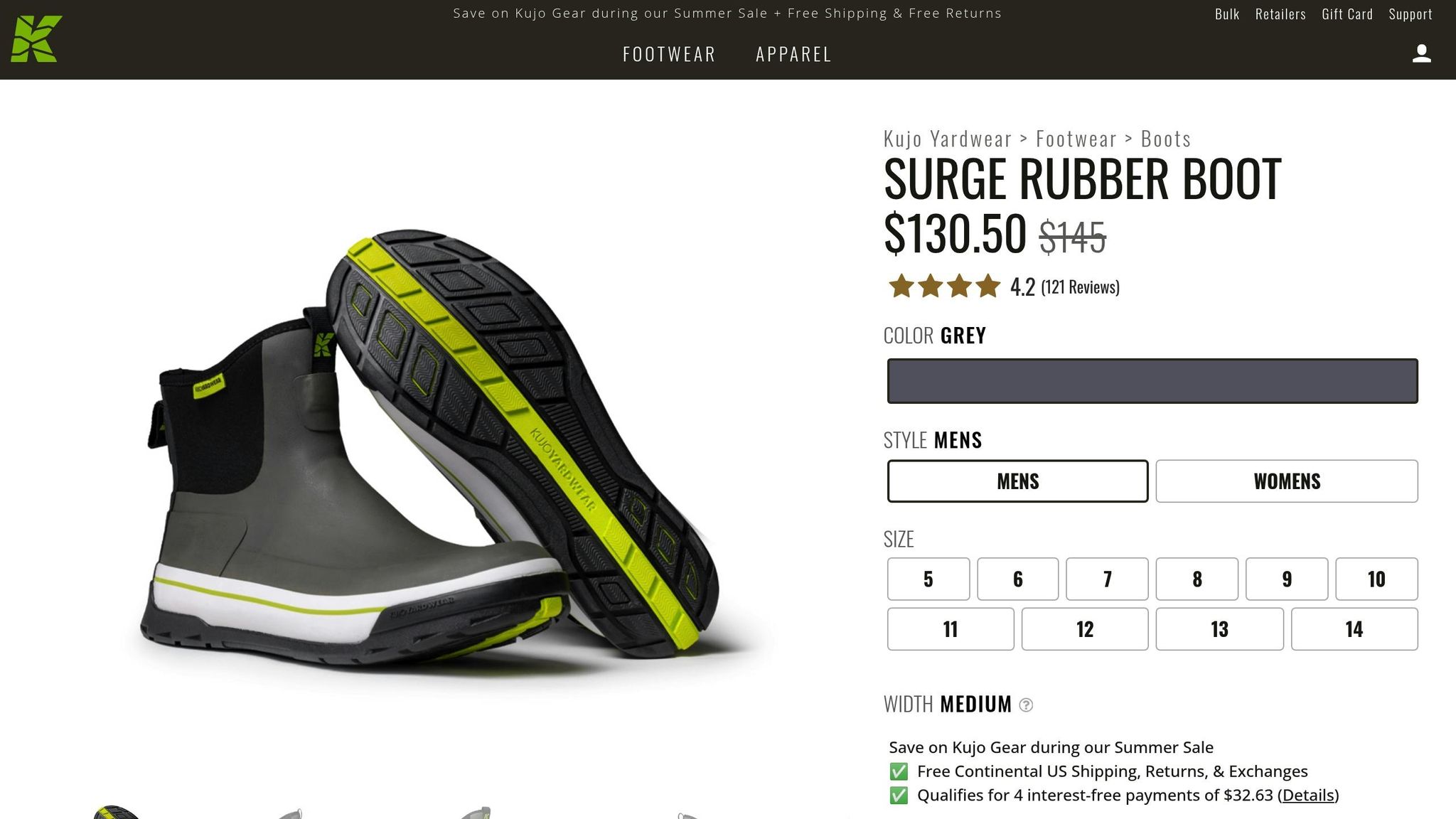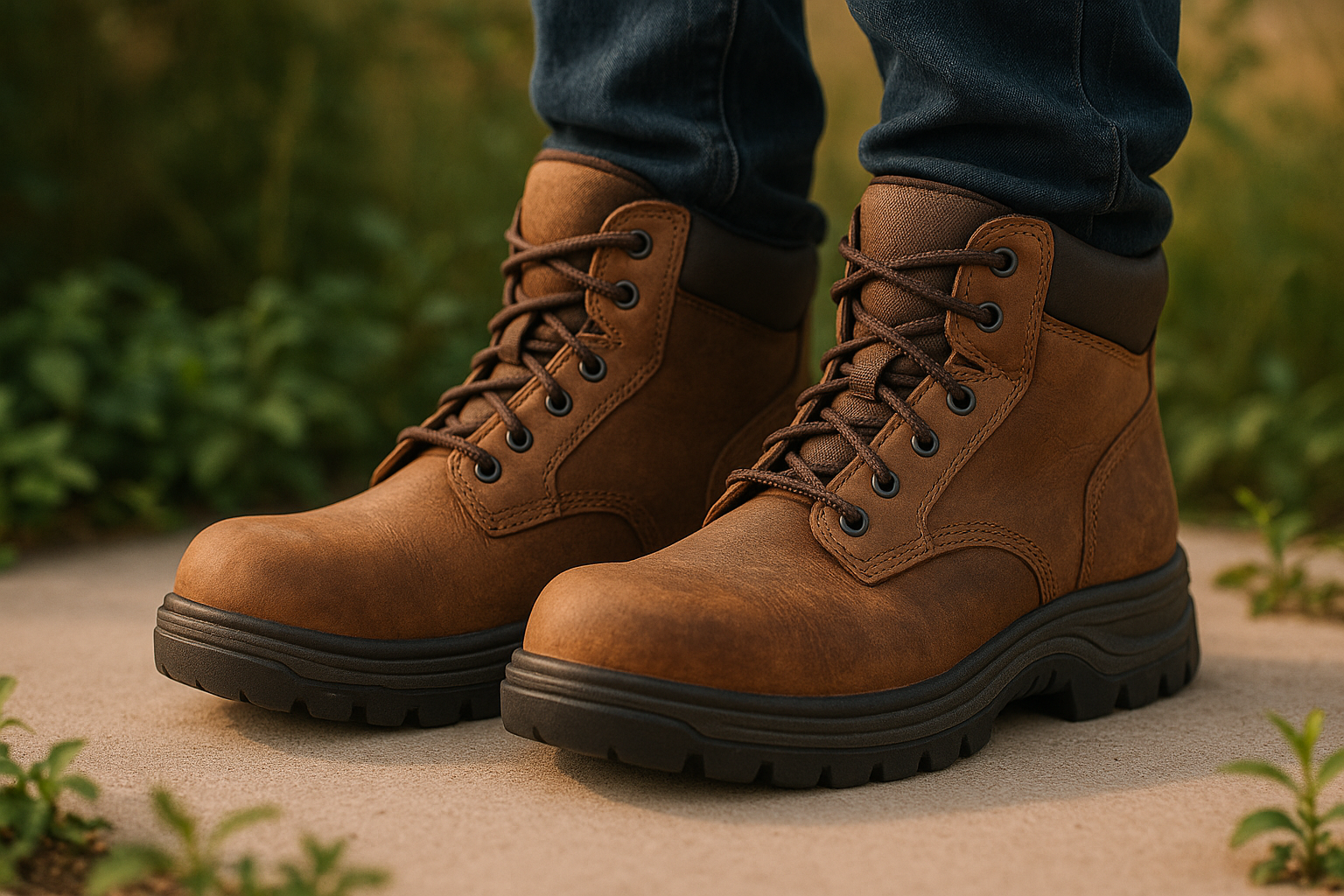When you work with bad sprays, your shoes can either keep you safe or bring big risks. Bad stuff can get into things like leather, cotton, or mesh, hurting your body and the world over time. The right boots, made from stuff like neoprene or rubber, are your best guard. Here’s what to know:
- Stay away from soak-up stuff: Leather, fabric, and cotton grab sprays and can’t get clean well.
- Pick stuff that fights chemicals: Choose rubber (natural, neoprene, nitrile, or butyl) or PVC, at least 14 mil thick.
- Get waterproof, tall boots: These stop splashes and keep a good seal.
- Read spray tags: They tell you the right shoes for your job.
- Keep your boots good: Check for breaks, wash them well, and get new ones if old.
Good boots keep you safe, follow rules, and stop bad sprays from spreading. Always put your health and safety first, not ease or cost.
The Best Boot for Pesticide Applicators – Kujo Yardwear Surge Rubber Boots

Knowing What Your Shoes Must Do If You Work with Pesticides
Pesticide labels, set by the EPA, are rules you must follow – not just tips. These labels tell you what kind of safe gear you need, including shoes. Not following these rules can bring big fines and other bad results.
How Labels Help Pick Safe Gear
Each label on a pesticide is like a map for safety, showing what Personal Protective Equipment (PPE) you need for your job. For shoes, labels tell you exactly what kind – whether you need boots that block chemicals, shoes that keep out water, or other safe choices. Look under the "Personal Protective Equipment" part of the label to know what to wear. The shoes you need can change based on what you are doing, like mixing strong chemicals, putting pesticides in tools, or using them in a field. Every job has its safety rules.
What Shoes That Block Chemicals Do
Shoes that don’t let chemicals through are made to keep all pesticides out. Materials like neoprene and rubber are common in making these shoe blocks. Search for shoes marked as waterproof or chemical safe – they’re key for jobs like mixing, loading, or using pesticides. Some labels might also point out other choices, like covers for shoes that block chemicals and go over shoes you already own. These covers work well if they’re made of the right stuff and fit tight to give full safety.
Bad Materials to Stay Away From
Some stuff, like leather, fabric, cloth, and cotton, is bad to use. These soak up chemicals, making them long-term risks. For example, dirty leather items – shoes, boots, or belts – can’t be cleaned and must be thrown out as dangerous waste. Unlike materials that block chemicals fully, soaking materials act like sponges, pulling in bad chemicals and keeping them near your skin. Knowing which materials to skip is as key as knowing which to pick.
Watching the labels on pesticides well helps you choose the right shoes and stuff, keeping you safe while you work.
Picking the Right Shoes: What They’re Made Of and How They’re Made
Once you know what the label says, the next thing to do is pick shoes made to keep chemicals out. Look at what they’re made of and how they’re made with safety and comfort in mind.
Top Choices for Chemical-Safe Shoes
When dealing with chemicals, picking the right shoe material is key. Here are some top picks:
- Natural rubber: Great at stopping chemicals, natural rubber shoes at least 14 mil thick are a solid choice to block chemicals.
- Polyvinyl chloride (PVC): PVC shoes resist many farm chemicals and are easy to wash. They should be at least 14 mil thick like natural rubber.
- Neoprene rubber: Tough and good against chemicals, neoprene rubber is a smart pick for working with chemicals.
- Butyl rubber: This kind of rubber is even better against some chemicals. Always check your chemical label to see if butyl rubber is needed.
- Nitrile rubber: Good for fighting chemical touches, nitrile rubber works well for jobs like mixing and loading chemicals.
Unlike leather or canvas, these options stop chemicals well.
How Shoes are Made for Safety and Ease
How your shoes are made is key for safety:
- Unlined inside: Choose shoes with no lining inside to keep chemicals out and make them easy to clean.
- Ankle-high: Shoes should go above your ankles to form a tight seal that keeps chemicals out.
Tucking Pants into Shoes
A simple but key move is to wear your pants over your shoes. This keeps chemicals out of your shoes and cuts down on skin contact. It’s an easy step that helps a lot with safety.
sbb-itb-c4006de
Picking the Right Shoes for Jobs and Places
When you deal with bug killers, it’s key to choose the right shoes. Each job, like mixing and loading, has its own risks – like getting splashed by chemicals. To stay safe and follow rules, it’s a must to pick shoes made for these tasks.
Shoes for Mixing and Loading Bug Killers
Mixing and loading bug killers can be very risky since you handle strong chemicals that can splash or spill. That’s why you need shoes that block these splashes well.
- Go for knee-high, waterproof boots with no lining: These boots work great as they keep your lower legs and feet dry, cutting down risks.
- Pick materials that fight off chemicals: Rubber or neoprene boots are the best as they push away the bug killers. Don’t go for leather or cloth, which can soak up chemicals and lower safety.
- Wear more protective gear: A long, waterproof apron that goes below your boot tops adds more protection when you mix liquid pesticides.
- Put pants over boots: This easy move stops chemicals from getting into your boots, making your job safer.
How to Check, Clean, and Keep Up Your Boots That Resist Chemicals
Taking good care of your boots makes them last longer and keeps you safe from bad chemicals. Regular checks and the right cleaning are key parts of the safety steps we talked about before.
Checks Before and After Use
Start each day by looking over your boots for any breaks or tears. Check for cracks, holes, or thin spots, mainly near the soles, seams, and ankles. A quick "balloon test" can help: fill the boot with water, press it, and look for leaks or light coming through – these are sure signs it’s damaged.
After you use your boots, look them over again. Even if they look okay, watch for any new stiffness or less bend. These might mean the boots’ safety layer is worsening and it’s time to get new ones.
Cleaning Steps
Once you’ve checked your boots, cleaning them the right way is the next task. Wash off dirt and leftover chemicals with water, then softly scrub all parts with a soft cleaner and a gentle brush. This keeps the chemical-resistant layer safe and makes sure the boots are okay for use next time.
How to Store and When to Get New Ones
After cleaning, make sure your boots are fully dry. Hang them in an airy spot for 24 hours. Once dry, keep them in a clean, cool, and stable place to keep them in good shape.
Even with good care, the chemical block of your boots will slowly get worse. Often check for signs of wear or less bend, and change them when needed. When not sure, remember to put your safety first before saving money on new boots. By following these care steps, your footwear stays a solid part of your safety gear, as shown in our usage and selection guide.
Main Points for Picking Good Pesticide-Safe Shoes
Taking care of your pesticide-safe shoes is as key as picking the right pair. Follow what the maker says for upkeep, cleaning, and putting them away to make sure they keep protecting you as needed.
Make it your daily thing to clean your boots, keep them far from chemicals, and keep them away from very hot or cold spots, direct sun, or wet air. Check your shoes often for any harm and get new ones right away if you have to.
Besides good care, learning is also a big part of staying safe. Programs like the ones from Online Pest Control Courses give state-okayed learning on how to stay safe with pesticides, including picking and using personal safety gear right. This learning makes sure you keep by the rules and stay safe.
FAQs
Why put on neoprene or rubber shoes when using bug spray?
When using bug spray, it’s key to wear shoes made out of neoprene or rubber. These stuff can keep out bad stuff, making a good wall that stops the spray from getting to your skin. This cuts down a lot on the risk of harm.
Plus, neoprene and rubber are waterproof and made to last, so they keep you safe and last long while you use them. Picking the right shoes keeps you safe and makes sure you follow rules for using bug spray.
How can I keep my bug spray-proof shoes good to use?
To keep your bug spray-proof shoes in top shape and safe, make sure to wash and dry them well after each time you use them. This stops bug spray bits from sticking and keeps the shoes from wearing out soon. Don’t use shoes made of canvas or leather, as these soak up the bug spray and are hard to clean well.
Get used to looking at your shoes for any signs of harm, such as cracks or soles that are worn out. If you see any problems, get new ones right away. Caring right for your shoes and swapping them when needed will keep the safety you need while using bug sprays.






